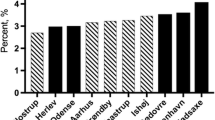Abstract
Within Western European countries the number of women and girls already genitally mutilated or at risk, is rising due to increasing rates of migration of Africans. The article compares legislative and ethical practices within the medical profession concerning female genital mutilation (FGM) in these countries. There are considerable differences in the number of affected women and in legislation and guidelines. For example, in France, Great Britain and Austria FGM is included in the criminal code as elements of crime, whereas in Germany and Switzerland FGM is brought to trial as bodily injury. So far trials only in France and Switzerland in connection with FGM resulted in convictions. France and Great Britain as former Colonial countries serve as an example of countries with a comparably great number of African immigrants. These countries have the best possibilities to intervene preventatively, due to legislation and detailed medical guidelines. For instance, an obligation exists in France to inform administrative and medical authorities if FGM is suspected. FGM so far is not explicitly part of the curriculum for medical training in any of the examined countries.
Similar content being viewed by others
Notes
See statement by TERRE DES FEMMES towards the use of the term “female genitale mutilation”: http://www.terre-des-femmes.de/.
Statement by the Swiss Federal Office of Justice, 04.02.1994.
See further: Überwindung weiblicher Genitalverstümmelung in Deutschland—Rechtspolitische Dimensionen: Lecture by Perdita Kroeger, Federal Ministry of Justice, at the Conference “Weibliche Genitalverstümmelung beenden: Erfahrungen aus Afrika und Europa—Perspektiven für Deutschland” December 2006 in Berlin. See http://www.de-fgm-konferenz2006-praesentation-kroeger.pdf.
See Austrian Institute for children’s rights and parental education, FGM – What does medical science know?, Vienna 2006, http://stopfgm.net, as well as UNICEF in cooperation with the Professional Organisation of Gynaecologists and TERRE DES FEMMES: “Cuts into Body and Soul – a Survey about the situation of genetically mutilated girls and women in Germany”, http://www.hamburger-illustrierte.de/content/htm/tic/2005/04/07/Doku_Vorderseiten.pdf.
References
Afrikanische Frauenorganisation in Wien. 2000. Die Anwendung der FEMALE GENITAL MUTILATION (FGM) bei Migrantinnen in Österreich, http://www.plan-s.ch/IMG/pdf/FGM_OGF_de-3.pdf.
Binder-Fritz, C. (n.d.). Die weibliche Genitalverstümmelung aus ethnomedizinischer Sicht: Grundlagen der transkulturellen Betreuung von genital verstümmelten afrikanischen Frauen in der Gynäkologie und Geburtshilfe, http://www.meduniwien.ac.at/sg/files/16/306/lernunterlage_block_15_binder-fritz.pdf, 2–3.
BMA. 2006. Guidance for UK doctors (part of publication: Female genital mutilation). http://www.bma.org.uk/ap.nsf/Content/FGM~Guidance?OpenDocument&Highlight=2,FGM.
Gynécologie suisse. 2005. Patientinnen mit genitaler Beschneidung, Schweizerische Empfehlungen für Ärztinnen und Ärzte, Hebammen und Pflegefachkräfte, http://www.sgggg.ch; http://www.iamaneh.ch.
Hulverscheidt, M. 2002. Weibliche Genitalverstümmelung. Diskussion und Praxis in der Medizin während des 19. Jahrhunderts im deutschsprachigen Raum. Frankfurt.a.M.: Mabuse Verlag.
Integra. 2007. Weibliche Genitale Beschneidung—Umgang mit Betroffenen und Prävention, Empfehlungen für Angehörige des Gesundheitswesens und weitere potentiell involvierte Berufsgruppen, http://www.bmz.de/de/themen/FGM/Downlads/Empfehlungen_zu_FGM Endfassg_ Zerm_2006_11_23.pdf.
Niggli, M.A., and A. Berkemeier for UNICEF Schweiz. 2007. Zur Frage der Strafbarkeit weiblicher Genitalverstümmelung gemäß den Typen I und IV. Rechtsgutachten.
Nyfeler, D., and D.B. Stöckli. 1994. Genitale Verstümmelung—Afrikanische Migrantinnen in der schweizerischen Grundversorgung. Arbeitsblätter Nr. 10, Institut für Ethnologie, Universität Bern, http://www.anthro.unibe.ch/unibe/philhist/anthro/content/e1765/e1766/e1940/e1942/e1943/files1944/ab10_ger.pdf.
Poldermans, S. 2006. Combating Female Genital Mutilation in Europe, http://www.stopfgm.net/dox/SPoldermansFGMinEurope.pdf.
Rahman, A., and N. Toubia, eds. 2001. Female genital mutilation. A guide to laws and policies worldwide. 2. impr. London: Zed Books.
Rosenke, M. 2000. Die rechtlichen Probleme im Zusammenhang mit der weiblichen Genitalverstümmelung. Dissertation. Frankfurt a.M.: Peter Lang.
Rühl, B. (n.d.). Ich brauch’ kein Mitleid”. In: UNICEF, in Zusammenarbeit mit dem Berufsverband der Frauenärzte und Terre des Femmes: Schnitte in Körper und Seele—Ein Umfrage zur Situation beschnittener Mädchen und Frauen in Deutschland, http://www.hamburger-illustrierte.de/content/htm/tic/2005/04/07/Doku_Vorderseiten.pdf, 9–11.
Smutny, P. 2001. Tradition als Tarnanzug für (Menschen)Rechtsverletzungen—Überlegungen zu FGM aus rechtlicher Sicht. In: FGM. Dokumentation der Veranstaltung weibliche Genitalverstümmelung (FGM) 8.5.2001, Wien, pp. 26–27. http://www.plan-s.ch/IMG/pdf/FGM_OGF_de-3.pdf.
TERRE DES FEMMES. 2007. Unterrichtsmappe: Weibliche Genitalverstümmelung. Tübingen.
Trechsel, S., and R. Schlauri für UNICEF Schweiz: 2004, Weibliche Genitalverstümmelung in der Schweiz. Rechtsgutachten.
Ungeheuer, B. 1991, Auf die Klinge setzen. In: DIE ZEIT, Nr. 44, 25.10.1991, p. 99.
WHO fact sheet: Female genital mutilation, http://www.who.int/mediacentre/factsheets/fs241/en/.
WHO Corporation. 2008. Eliminating female genital mutilation. An interagency statement. OHCHR, UNAIDS, UNDP, UNECA, UNESCO, UNFPA, UNHCR, UNIFEM, WHO. Geneva: World Health Organization.
Websites
German Medical Association (Bundesärztekammer): Recommendations regarding the treatment of female patients after FGM was carried out: http://www.bundesaerztekammer.de/pge.asp?his=0.7.47.3207, 25.11.2005; http://www.frauenrechte.de/tdf/index.php?option=com_content&task=category§ionid=13&id=111&Itemid=84.
Journal Sprechzimmer von 13.06.2008. http://sprechzimmer.ch/sprechzimmer/Frauen/Genitalverstuemmelungen_Erstes_Urteil_in_der_Schweiz/php.
NZZ online vom 26.6.2008 http://www.nzz.ch/nachrichten/zuerich/elternpaar_wegen_beschneidung_seiner_tochter_verurteilt_1.769848.html.
Royal College of Obstetricians and Gynaecologists, RCOG Statement No. 3, Female Genital Mutilation, 200, http://www.rcog.org.uk/womens-health/clinical-guidance/female-genital-mutilation.
Studienplanführer Diplomstudium Humanmedizin N202 Block 15, http://www.meduniwien.ac.at/index.php?id=92&content_id=sg/18/202/5242.php&parent_id=5232.
Sources for English Versions of the Laws: http://www.opsi.gov.uk/ACTS/acts2003/ukpga_20030031_en_1; http://www.legifrance.gouv.fr/html/codes_traduits/code_penal_textan.htm.
Note
Since the research reference date 2009 (2008: 60 years Universal Declaration of Human Rights), there were made efforts in Germany and Switzerland to change the legislation, see further: www.bundesrat.de/cln_152/SharedDocs/Drucksachen/2009/0801-900/867-09, templateId=raw, property=publicationFile.pdf/867-09.pdf; http://www.aerzteblatt.de/nachrichten/39982/Genitalverstuemmelung_soll_Straftatbestand_werden.htm; http://www.terre-des-femmes.ch/de/fgm/fakten; www.terre-des-femmes.ch/files/TERRE_DES_FEMMES_Schweiz_Stellungnahme_Vernehmlassung_FGM.pdf.
Acknowledgments
I like to thank the colleagues of the Forum Medicine and Human Rights at the Professorship for Medical Ethics Erlangen-Nuremberg University, in particular Prof. Andreas Frewer and Janna Graf. A new research project on the experience with FGM in Germany is under progress. Furthermore, I want to thank Terre des Femmes (TDF) and the cited colleagues for our good cooperation.
Author information
Authors and Affiliations
Corresponding author
Rights and permissions
About this article
Cite this article
Krása, K. Human rights for women: the ethical and legal discussion about Female Genital Mutilation in Germany in comparison with other Western European countries. Med Health Care and Philos 13, 269–278 (2010). https://doi.org/10.1007/s11019-010-9245-4
Published:
Issue Date:
DOI: https://doi.org/10.1007/s11019-010-9245-4




